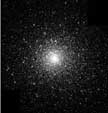The Hidden Lives of Galaxies - The Components of a Galaxy
C. The Components of a Galaxy
A galaxy may be made up of two visible components. The two components are the disk and the bulge. Spiral galaxies have most of their stars in a disk. Elliptical galaxies do not have a disk. The stars may be single stars, double, or multiple stars, or may be part of clusters. In the disk, stars cluster into open clusters (also called "galactic clusters") which are asymmetric group of stars. There may be as few as ten or as many as 2000 stars in an open cluster.

|
| A near-infrared image of the Milky Way Galaxy |

|
| The Pleiades |
In our Galaxy, the Pleiades is the well known example of an open cluster (see image left), and it contains a few hundred stars. Open clusters tend to be the younger of the type of clusters which appear in a galaxy. The galaxy disk also contains clouds of gas and dust, called nebulae. Some nebulae result from the death of stars, while others are the place where stars are being created. Some nebulae emit light, while others absorb light. The stars, clusters, and nebulae in the disk rotate around the center of the galaxy. In our Galaxy, it takes 200 million years for our Sun to make a full revolution around the center. In addition to the disk, spiral galaxies also have a "bulge", which is a large, squashed sphere surrounding the galaxy's center. This region is composed of stars, dust, and gas. In the Milky Way Galaxy, the bulge contributes about 1/5 of the total light of the galaxy. The bulge consists of older stars and not very much gas or dust. Above and surrounding the bulge, stars cluster into globular clusters (see image right), which are collections of up to hundreds of thousands of stars bound together in a tight spherical swarm. Since they consist of old stars, globular clusters can be used to determine the age of the galaxy. In globular clusters, the stars move about just as bees swarm near their hive.

|
| The Globular Cluster M80 |
Elliptical galaxies consist of just one visible component, the bulge. A good example of this is M87. Elliptical galaxies contain old stars and a small amount of gas and dust. Stars in these galaxies collect into globular clusters, but not open clusters.
In some irregular galaxies, one can see the individual stars, nebula and clusters, while in other irregular galaxies we cannot see these same objects. Irregular galaxies have a disk, but no spiral arms. However, these galaxies do have a mixture of old and young stars combined with a large amount of gas and dust.
Recommended Activity: Open Clusters vs. Globular Clusters

